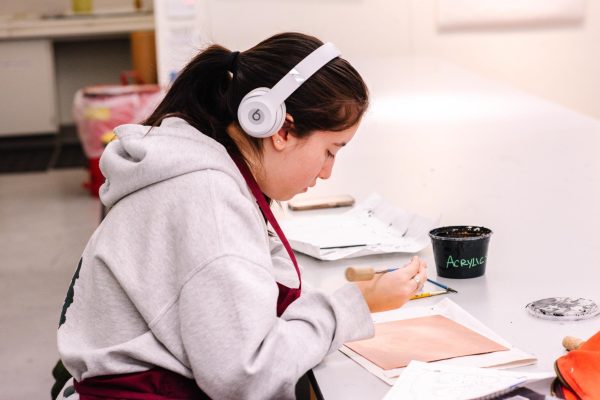The other side of the disc: “Fearless (Taylor’s Version)” review
April 16, 2021
It isn’t often that a musician gets to re-record most of their music. A few songs here and there, maybe with some lyric changes or an additional guest singer at the most, but rarely the bulk of their albums. For Taylor Swift, however, this chance has become a reality with the re-release of her album “Fearless,” and many more to come.
Swift’s first six albums—her self-titled debut, “Fearless,” “Speak Now,” “Red,” “1989,” and “Reputation” —have all been produced by her original record company, Big Machine Records. In 2019, Swift made a post on her tumblr account stating that Scooter Braun and Scott Borchetta, her producers at Big Machine Records, had been prohibiting her from performing her music that had been produced by them. To Big Machine Records, performing these songs was seen as re-recording them. As Keziah A. Douglas for The Harvard Crimson writes:
“By owning the masters (which refers to the first recording of a song), Braun has complete control over the six Swift albums produced under her former label, Big Machine Records” (1).
However, after Swift’s record deal with Big Machine Records ended ten years after the release of her first album, and she joined Universal Music Group—who offered her complete control over her music, which is why her latest albums have copyrights to her, rather than a record label like Big Machine Records. Swift made the decision to begin rerecording her albums owned by Big Machine to place them in competition with the original masters, rather than attempting to buy the masters back from Braun. As Keziah A. Douglas writes:
“By re-recording her own songs, Taylor would be able to circumvent the purchase of her masters and put her new recordings in direct competition with her old recordings” (1).
Which is where we find ourselves today, with the release of “Fearless (Taylor’s Version)” on April 9. This re-recording, though it lacked lyrical changes overall, truly showed Swift’s growth in her career over the last twelve years since the original album was released, with the development of her vocals, tone and instrumentals. While the original “Fearless” shared honest and raw tracks written by an 18-year-old girl experiencing her first romances and heartbreaks, the trials and tribulations of high school, and feeling like she had been growing up too fast, “Fearless (Taylor’s Version)” shared the growth, regrets, and nostalgia only a 31-year-old woman could experience.
The album features all nineteen songs featured on the “Fearless” platinum album, as well as “Today was a Fairytale,” which was a single released around the time of “Fearless,” and five songs from the “vault” that Swift had yet to record or release prior to these re-records, two of which—“You All Over Me” and “Mr. Perfectly Fine”—were released prior to the album’s release.
Many of the songs now seem to share a new meaning, or at least a different spin on the original words, which can only come with time and age. Songs like “White Horse” and “You’re Not Sorry” now sound much more like a woman who has spent years being put through hell and back by ex-boyfriends and her record label, as well as the general public that considered it cool to hate her for a while, rather than a teenager experiencing one of her first major heartbreaks.
Like these songs, “Fifteen,” which was one of the most well-known songs from the original “Fearless” album, had evolved in meaning. What was originally a teenager reflecting on her high school years now sounds like a letter to a past self, or a mother talking to her teenage daughter before high school. The lyrics “But in your life you’ll do things greater than / Dating the boy on the football team” especially resonate with this, since the first recording had much of a hopeful outlook towards being successful, while “Taylor’s Version” has a sense of reflection and nostalgia. Swift, at the time of writing and recording the original “Fearless,” probably had no idea of the success she would reach, including 11 Grammy awards— three of them being Album of the Year—and winning a total of 382 awards throughout her 14 years in the music industry, as well as being named Artist of the Decade by Billboard.
Vocally, this album not only shows Swift’s growth as an artist, but also has been modified slightly to fit the style of her latest albums, “Folklore” and “Evermore,” both of which came out late 2020. Many of the songs, such as “Love Story,” and the piano version of “Forever and Always” have less of a commercialized pop radio sound, and the more ‘folktronica’ tone of her latest music.
Swift’s tone and diction while singing had also improved greatly, which most likely came from years in the industry. Many of the higher notes no longer sound like she is straining to hit them, but rather floats up to the notes with ease, such as in “Forever and Always.” In comparison to the original album, “Fearless (Taylor’s Version)” shows Swift’s growth as an artist and singer.
Overall, I really enjoyed “Fearless (Taylor’s Version).” I’ve been an on-and-off fan of Swift since the “country era” of her debut album, “Fearless,” and “Speak Now,” and although I took a break from listening during her “Reputation” and “Lover” eras, “Folklore” and “Evermore” pulled me right back in. Every song had new elements of growth and interest from their original counterparts, and the songs from the Vault allowed for the experience of listening to a song off the album for the first time.
While I didn’t love the duets featured on “Fearless (Taylor’s Version)”—“That’s When” featuring Keith Urban was a bit too country sounding for my taste, but it made sense for the time it had been written, “Breathe” featuring Colbie Caillait always felt out of place and jarring when sandwiched between “You Belong With Me” and “Tell Me Why,” and “You All Over Me” featuring Maren Morris just wasn’t for me, though I can’t place why—the album overall hit high marks. I would have liked to see more of a duet with the songs featuring women, rather than background harmonies, but this sort of issue has been an overarching theme in Swift’s music career, as seen with “No Body, No Crime” featuring HAIM, and “Coney Island” featuring The National, both of which are on “Evermore.”
However, standouts for me had been “The Way I Loved You,” “Forever and Always”—both the standard and the piano version—“Mr. Perfectly Fine,” “Today Was a Fairytale,” and “You Belong With Me.” These songs had elevated drastically from their original version in the vocals and instrumentals, or were brand new and stood out from the group, such as “Mr. Perfectly Fine,” as well as filling me with immense amounts of nostalgia.
“Fearless (Taylor’s Version)”is a delightful blast from the past that reminded me all too much of my younger days of listening to the original album’s CD in the car or in my room until the disc had completely worn out. I, like many other fans of Swift, cannot wait for the other albums, and all of the nostalgia that will come with them.






























































